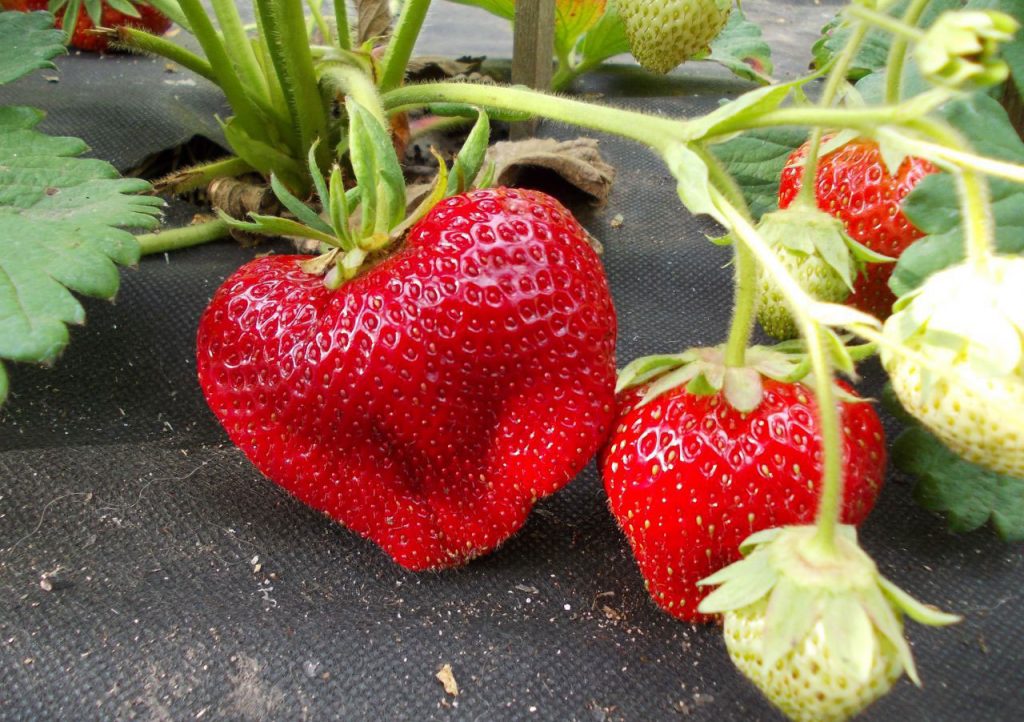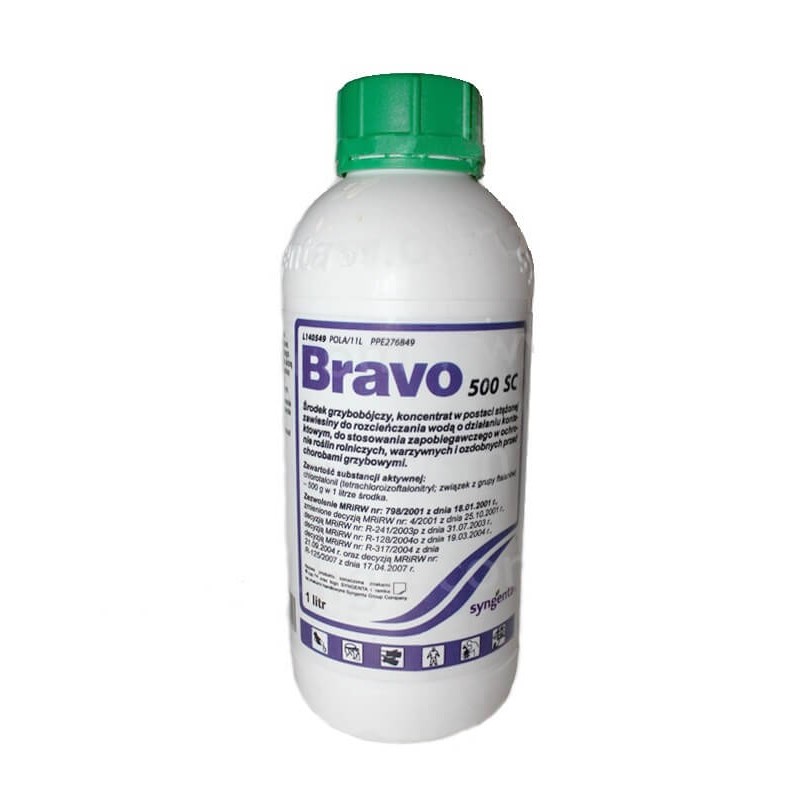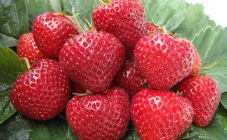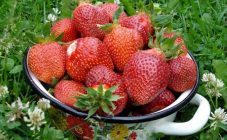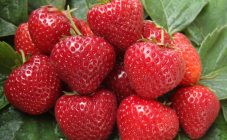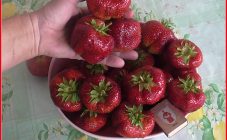Content:
There are many types of strawberry varieties, but the more valuable are those that are unpretentious in care, resistant to adverse weather events and give an excellent harvest. This article will discuss the description of the Marmalade strawberry variety, how it differs from the rest and the intricacies of its breeding.
This berry is large-fruited, with short daylight hours, and yields once a year. With sunny weather, as a rule, in the southern regions and with proper care, re-bearing can be achieved at the end of August.
Strawberry (Marmalade variety is sometimes called Marmaladka, Marmaladnitsa) appeared in 1989 in Italy by breeding the Holiday and Gorella varieties. Its original name is Marmolada Onebor. For the unusual taste of berries, the people gave her names: strawberry Marmalade, strawberry Marmalade or strawberry Marmalade.
Strawberry Marmalade: variety description
The Gummy strawberry variety is considered semi-renovated and mid-early. The first harvest is harvested at the beginning of June, the main fruiting is observed at the end of June. In warmer regions, it is possible to achieve a second harvest wave by feeding the plants and removing all leaves. And the berries will become much larger than at the beginning of the fruiting season.
Powerful and spreading bushes of strawberry varieties Marmalade of compact form. Leaves are dark green, highly erect. Flowers have high legs, in large numbers are located above the leaves. This plant forms a lot of whiskers, so there will be no difficulties with its reproduction.
The main characteristics of the variety:
- This variety has good drought tolerance, but requires moderate watering, otherwise the berries may lose their juiciness. With abundant soil moisture, the risk of fungal diseases increases, which can harm the bush and fruits.
- It has a high yield from 750 g to 1.5 kg per bush with proper care.
- The largest amount of harvest occurs in the first 2 years after planting, at 3 and 4 years, fruiting decreases, so you need to periodically update the bushes.
- Marmalade berries are sweet in taste with tender, juicy pulp.
- The bushes are distinguished by their splendor and an abundance of flowers, many mustaches are formed.
Most often, the fruits are used in the preparation of jams, compotes and other tasty preparations.
Description of strawberry fruit:
- Berries of strawberries of the Marmeladka variety are quite large in size, weighing up to 25 g, some specimens can reach 45 g.
- The fruits are cone-shaped, the tip is sharp, widened at the base.
- Strawberries with a deep, bright red color that approaches a dark shade have a characteristic shine. The seeds are shallow planted, yellow in color, the taste is almost not felt. When cut, the pulp is soft pink in color. After the final ripening, the tip of the berry may turn white.
- Fruits with a pleasant strawberry aroma, high sugar content. The pulp is not hard, more sweetness to the tip.
- There are berries with a comb-like surface.
Features of crop cultivation
To grow strawberries of the Marmaladka variety, warm climatic conditions are needed. It is best to choose an area with neutral soil and constant access to the sun.Where the soil is acidic, it is not recommended to plant the variety; lime should be added before planting, otherwise the yield will decrease.
It is better to plant strawberries in places where lettuce, carrots, beets or cucumbers previously grew. It is not advisable to use the soil after nightshade crops such as tomatoes or potatoes, because they deplete the soil very much.
The most successful planting time for strawberries of the Marmeladka variety is the second half of August. The plant will be able to adapt well and get stronger before the upcoming wintering. The first fruits will appear next year.
Before planting, you need to prepare the beds, apply nutritious fertilizers and dig up the soil. Humus or peat are suitable as top dressing. 1 bucket per m² is enough.
The holes need to be dug so that the roots of the strawberry are completely placed in it and feel free. The root system is sprinkled with earth so that air remains available, there is no need to compact the soil. You need to water it for 3 days, then rooting will happen much faster.
Further care
One of the important processes of caring for this species is pruning. Untimely removal of a large number of strawberry whiskers of Marmalade can lead to neglect of the ridge and uncontrolled growth of the plant. A similar procedure is carried out in the fall, after the last crop has been harvested. In order for the strawberries to grow strong enough, in the first year after planting, it is recommended to trim all whiskers and remove the inflorescences that appear.
As for irrigation, drip irrigation is considered the most favorable option. If it is not possible to carry out such watering, you can use an ordinary watering can. It is necessary to water the strawberries of the Marmalade variety, focusing on the weather conditions: on hot days this should be done regularly, in rainy weather it is better to do it altogether.
It is worth not overdoing it with water, as this will affect the taste of the berries: they will lose sweetness and become watery, and in a more severe case, rotting may begin. Lack of moisture also negatively affects strawberries.
After moistening the soil, it is recommended to weed and loosen the beds. This should be done carefully and not deeply, about 10-12 cm, trying not to touch the root system. Weeds are removed along with the roots to prevent their reappearance.
The mulching procedure allows you to retain moisture at the roots. Mulch is applied in summer and autumn, covering for the winter (if necessary). For this purpose, you can use cardboard or sawdust, and before winter frosts - spruce branches. For better heat preservation, a special non-woven material can be put on top of the spruce branches.
You also need to provide strawberries of the Marmalade variety with all the necessary trace elements, and then it will regularly bear fruit and cope with diseases. For this, you can use organic and mineral fertilizers.
Description of making strawberry dressings:
- Peat and humus are introduced before planting in an amount of about 8 kg per 1 m².
- Nitrogen fertilizers are used when the first greens appear. Urea is best (about 35 grams per bucket of water).
- During the flowering period, potassium nitrate is used (30 g per 1 bucket of water).
- On the eve of wintering strawberries, rotten manure with wood ash (1: 1) is used.
As a preventive measure for the appearance of diseases, it is useful to regularly treat the plant with fungicides and insecticides.The main thing is to strictly act in accordance with the instructions and observe the dosage.
Advantages and disadvantages of the variety
The positive qualities of the Marmalade strawberry variety include:
- This garden strawberry is resistant to many diseases.
- Used by both amateur gardeners and farmers for sale.
- Possesses high productivity.
- The berries are distinguished by good transportability, they are able to maintain an attractive appearance and taste even during long transportation.
- Strawberries propagate easily through whisker formation.
- The fruits have a rich strawberry aroma.
Description of the cons of the variety:
- Fruit jelly does not tolerate acidic soils.
- The greatest harvest of strawberries Marmalade gives in the southern regions with a mild climate.
- Does not tolerate waterlogging and severe frosts. In winter, requires shelter.
- Strawberries are quite whimsical to care for.
- After 2 years, the yield drops noticeably.
- When planting a plant, a lot of space is required, otherwise the berries will begin to shrink.
Thus, due to its advantages, the Marmalade strawberry variety is worthy of any vegetable garden, especially since even a novice summer resident can grow it. But for this you need to take into account all the nuances of cultivation listed above.

